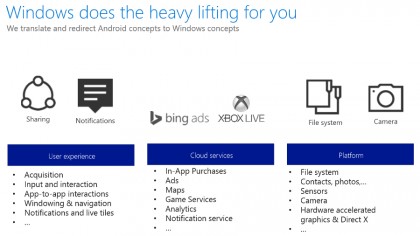How will Android support work in Windows 10 for Phones?
We discuss what Android support can achieve, and what it can't
Port limitations
Microsoft calls all these options for porting code bridges, and they're meant to make it easier and cheaper for developers to bring apps to Windows 10. "We're making sure we can reduce the cost of coming to our platform, so you can build efficiently and reuse the code you've already built as much as possible instead of people porting the same code over and over again," says Gallo, but he freely admits there's no magic to making this easy. "None of this is a perfect solution. We're saying 'bring your code and we'll try and work through this as well as we can'. It's a starting point."
He doesn't think the Android and iOS support will be a disincentive to build native Windows apps, because of the limitations of the ported apps. "The user experience [of an app designed for a small device] will work on the desktop but it won't be decent across the spectrum," he pointed out; "it may not be an effective experience."
An Android or iOS app on a Windows 10 phone that's plugged into a screen and keyboard using the Continuum feature won't have a desktop interface to switch to. He believes developers will want to make a good app, using a shared core of code, rather than a sloppy port, and that developers who want to make an impression on those engaged customers will do the extra work required. Of course, that remains to be seen.

Reconnecting with developers
What the Android support will enable are the simpler apps built by organisations that want to have apps but don't want to spend a lot on them. "Banks and hotels can be good enough everywhere," suggests Gallo. And of course it will help give Windows users access to the large number of Android apps in China, which use AOSP and don't have any Google services to be concerned about.
One big advantage Microsoft sees is a chance to get developers at least considering Windows 10. "We want to reconnect with developers. That's been our heritage and we think we lost our way," says Gallo. "We made several false starts and now we're trying to fix that."
Sign up to the TechRadar Pro newsletter to get all the top news, opinion, features and guidance your business needs to succeed!
- 1
- 2
Current page: Limitations and reconnecting with devs
Prev Page Introduction and Microsoft servicesMary (Twitter, Google+, website) started her career at Future Publishing, saw the AOL meltdown first hand the first time around when she ran the AOL UK computing channel, and she's been a freelance tech writer for over a decade. She's used every version of Windows and Office released, and every smartphone too, but she's still looking for the perfect tablet. Yes, she really does have USB earrings.